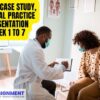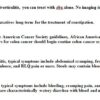Description
NR 511 Final Exam Part 3 (100/100 Points)
- What is the name of the test used to assess for nerve-root compression?
- Hughes is a 46-year-old African American man who is in your primary care office for a physical examination. You recommend which of the following as screening for prostate cancer?
- Which of the following individuals most likely will have a false-negative reaction to the Mantoux test?
- Specific conditions demonstrate fluid in the scrotum on transillumination. These include
- Max, age 16, comes into your office after having been in a fight and sustaining a human bite on his fist. Your first course of action is to
- Marisa, age 42, has celiac disease. She is prone to osteopenic bone disease as a result of impaired calcium absorption because of
- Decreased bladder capacity; bladder irritation from a urinary tract infection, tumor, stones, or irritants such as caffeine and alcohol; and central nervous system disorders or spinal cord lesions are all contributing factors to
- Samuel wants his newborn son to be circumcised, but it is noted that the baby has hypospadias. What do you tell Samuel?
- Which of the following would be considered the highest risk factor for the development of testicular cancer?
- Jeff, age 20, presents to the college health clinic with complaints of difficulty passing his urine and a discharge from his penis. Upon further investigation, you note that the discharge is urethral in origin. The most common cause of these symptoms in the young adult male population is
- Bernard, age 59, presents to the emergency department with a diagnosis of priapism. Despite the application of cold compresses and pain medications, relief is unsuccessful. What is the treatment of choice?
- You are referring a 73- year- old client for the management of his prostate cancer with hormonal therapy. It is understood that goserelin acetate (Zoladex) acts as a method of androgen ablation by
- Samuel, a 62- year- old, who takes many different medications, is complaining of erectile dysfunction. The nurse practitioner knows that several medications could be the cause of Samuel’s problem. Which of his medications is most likely the culprit?
- Milton, a 72- year- old unmarried, sexually active white man, presents to your clinic with complaints of hesitancy, urgency, and occasional uncontrolled dribbling. Although the nurse practitioner suspects benign prostatic hypertrophy, what else should the differential diagnosis list include?
- Benign prostatic hypertrophy is a common finding as men age. Classically, this condition may begin with difficulty initiating the urinary stream, hesitancy, urgency, postvoid dribbling, urinary frequency, nocturia, urinary retention, sensation of a full bladder immediately after voiding, and incontinence. These preceding symptoms would also cause the nurse practitioner to consider what other condition as a differential diagnosis?
- What is the most common prostatitis syndrome found in males of any age?
- Bloody penile discharge is most likely to be associated with which of the following?
- The most common gram-negative bacteria that cause both acute and chronic bacterial prostatitis is
- A history of urinary tract infections in males is often seen in men with chronic bacterial prostatitis. Other signs and symptoms of chronic bacterial prostatitis include
- The U.S. Preventive Services Task Force (USPSTF) recommends against prostate-specific antigen (PSA)-based screening for prostate cancer. They grade the evidence related to PSA screening as
- When performing a prostate examination, the nurse practitioner notes a tender, warm prostate. What would be the most likely differential diagnosis?
- Jordan, age 32, appears with a rapid onset of unilateral scrotal pain radiating up to the groin and flank. The nurse practitioner is trying to differentiate between epididymitis and testicular torsion. Which test should be the provider’s first choice?
- What differentiates prostate cancer symptoms from benign prostatic hypertrophy (BPH) symptoms?
- If a patient presents with symptoms of benign prostatic hypertrophy, a digital rectal examination is indicated in order to
- Mikey had an undescended testicle at birth, and at age 2 it remains in the inguinal region. His mother is afraid of surgery and asks for your advice. How do you respond?
- In older adult males, which of the following is the most common cause of nocturia?
- Thomas, age 69, comes to your office for the results of her DEXA scan. She reports that her mother had osteopenia before she died. The DEXA scan result shows a T score of −2.7 in the hip and −2.8 in the spine. You explain to her that her results show
- Jill, age 49, has recently begun a rigorous weight-lifting regimen. She presents to the primary care office with a shoulder dislocation. Which of the following clinical manifestations leads the nurse practitioner to suspect an anterior shoulder dislocation over a posterior dislocation?
- The most common cause of cauda equina syndrome is
- Gout is caused by urate crystals being deposited in certain joints leading to acute pain, erythema and edema. Gout typically occurs in the joint of the
- Bone mineral density (BMD) testing is recommended by the National Osteoporosis Foundation for which of the following client populations to assess whether they are at high risk for osteoporosis?
- In assessing an infant for developmental dysplasia of the hip (DDH), the practitioner places the infant supine, flexes the knees by holding the thumbs on the inner mid-thighs, with fingers outside on the hips touching the greater trochanters, stabilizes one hip, and abducts and gently pulls anteriorly on the other thigh. If this external rotation feels smooth with no sound present, there is no hip dislocation. This is
- Emily, age 12, presents to the clinic with another muscle strain from one of her many sports activities. The nurse practitioner thinks that the patient was probably never taught about health promotion and maintenance regarding physical activity. What information should be included in patient teaching?
- Kelly, age 80, has a curvature of the spine. This is likely to indicate which age-related change?
- When Maxwell, age 12, slid into home plate while playing baseball, he injured his ankle. The nurse practitioner is trying to differentiate between a sprain and a strain. A sprain
- Which of the following is NOT a management principle for an acute musculoskeletal injury that does not require emergent treatment?
- Lillian, age 70, was told that she has osteoporosis. When she asks you what this is, you respond that osteoporosis
- Colchicine may be used to terminate an acute attack of gouty arthritis as well as to prevent recurrent episodes. The mechanism of action is to
- To aid in the diagnosis of meniscus damage, which test should a nurse practitioner perform?
- Upon assessment, the nurse practitioner notes unilateral back pain that had an acute onset and increased when standing and bending. A straight-leg test is negative. The most likely differential diagnosis is
- The straight leg-raising maneuver can be used to diagnose
- Jennifer says that she has heard that caffeine can cause osteoporosis and asks you why. How do you respond?
- You are assessing Jamal, age 16, after a football injury to his right knee. You elicit a positive anterior/posterior drawer sign. This test indicates an injury to the
- Margaret, age 55, presents to you for evaluation of left hand and wrist pain and swelling after a slip and fall on the ice yesterday. On examination, you note tenderness at her “anatomical snuffbox.” You know this probably indicates a(n)
- Black men have a relatively low incidence of osteoporosis because they have
- Joan, age 76, has been given a diagnosis of osteoporosis confirmed with a dual- energy x- ray absorptiometry (DEXA) scan. The nurse practitioner has educated her about the importance of increasing calcium and vitamin D in her diet and starting a low-impact, weight-bearing exercise program. The nurse practitioner is also going to start the patient on medial management. Joan asks about a drug called a “SERM” that she has heard has been shown in studies to prevent vertebral fractures. Which of the following pharmacological therapies for osteoporosis is classified as a selective estrogen receptor modulator (SERM)?
- Beth, age 49, comes in with low back pain. An x- ray of the lumbar/sacral spine is within normal limits. Which of the following diagnoses do you explore further?
- Sandy, age 49, presents with loss of anal sphincter tone, impaired micturition, incontinence, and progressive loss of strength in the legs. You suspect cauda equina syndrome. What is your next action?
- June, age 67, presents with back pain with no precipitating event. The pain is located over her lower back and muscles without sciatica, and it is aggravated by sitting, standing, and certain movements. It is alleviated with rest. Palpation localizes the pain, and muscle spasms are felt. There was an insidious onset with progressive improvement. What is the most likely differential diagnosis?
- Ankylosis is defined as:






